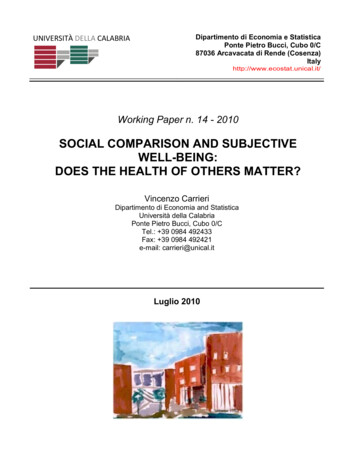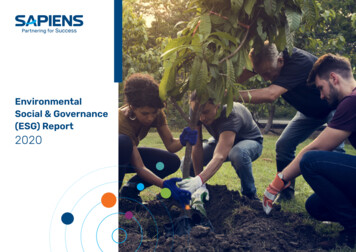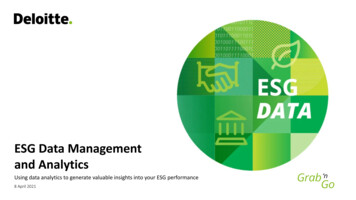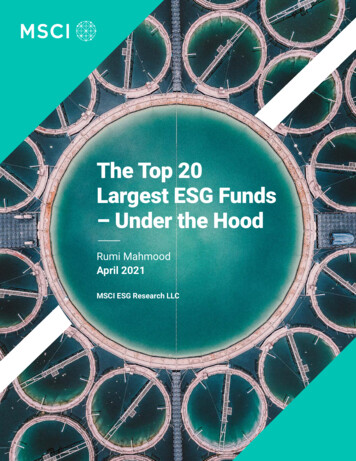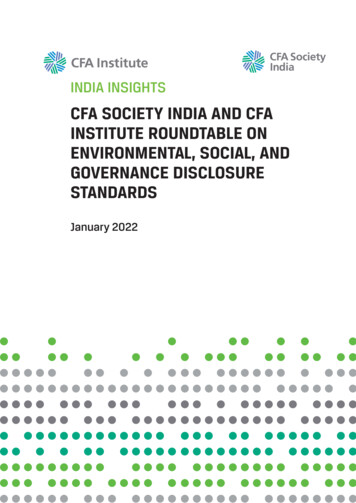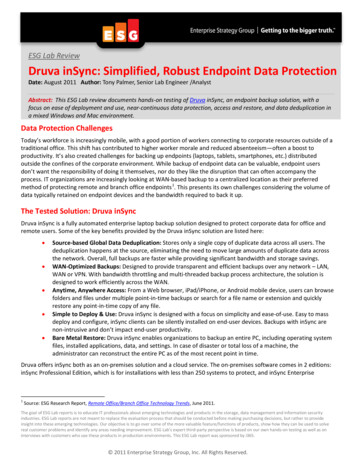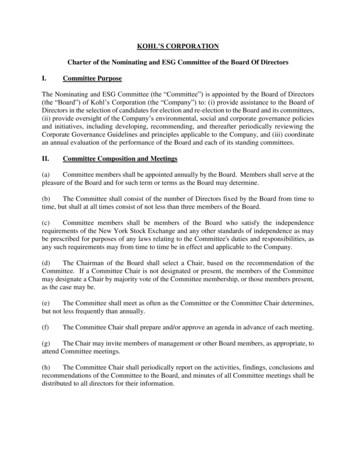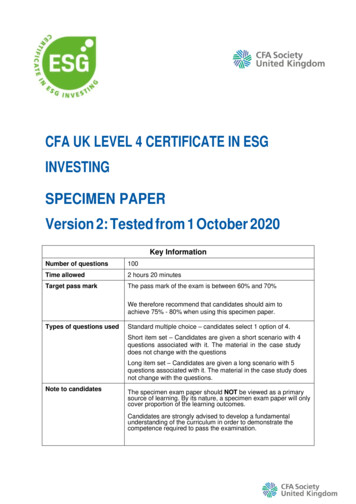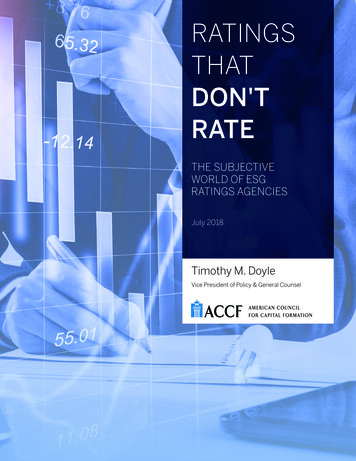
Transcription
RATINGSTHATDON'TRATETHE SUBJECTIVEWORLD OF ESGRATINGS AGENCIESJuly 2018Timothy M. DoyleVice President of Policy & General Counsel
Page intentionally left blank2
ABOUT THE AMERICAN COUNCILFOR CAPITAL FORMATIONFor more than four decades, the American Council for Capital Formation (ACCF),a 501(c)(6) nonprofit, nonpartisan organization has advocated tax, energy,environmental, regulatory, trade and economic policies that encourage saving andinvestment, economic growth, and job creation. The ACCF is uniquely able to playthis role because of its bipartisan credibility with Members of Congress and theWhite House, its highly respected research and analysis of legislative and regulatoryinitiatives, and the respect it has earned in the media.For more information, please contact the ACCF1001 Connecticut Avenue, N.W., Suite 620,Washington D.C. 20036 Telephone: 202.293.5811email: info@accf.org website: ACCF.ORG.About the AuthorTimothy M. DoyleTim Doyle is Vice President of Policy and General Counsel of the American Councilfor Capital Formation and its affiliate, the Center for Policy Research. Doyle has adiverse policy and legal background in multiple areas including energy, environment,oversight, corporate governance, and regulatory issues.Prior to joining the ACCF, Doyle served as Senior Counsel for the House Science,Space, & Technology Committee and Staff Director for its Oversight Subcommittee.There he successfully managed oversight staff involving multiple investigations. Inaddition, he established, developed, and maintained strategic relationships at thesenior levels in Congress regarding energy policy and its corresponding regulatoryframework. Doyle also served as Senior Counsel and Director of Investigations for theHouse Committee on Natural Resources.Doyle holds a JD from Michigan State University as well as a BA with a dual major inPolitical Theory & Constitutional Democracy and Criminal Justice. During law school,he clerked for the Department of Justice in Washington D.C. at the U.S. Attorney’sOffice. He also worked his way through law school at the Senate Majority Policy Officein the Michigan Senate.3
RATINGS THATDON'T RATETHE SUBJECTIVE WORLD OFESG RATINGS AGENCIESCONTENTSExecutive Summary 5Introduction: The Growing Investor Focus on ESG 6Background on Ratings Agencies 6Disclosure Limitation and Lack of Standardization 8Exploring Ratings Biases 9Bias #1: Larger companies obtain higher ESG ratings 9Bias #2: Geographical bias toward companies in regions with high reporting requirements 10Bias #3: ESG agencies oversimplify industry weighting and company alignment 11Inconsistencies Between Rating Agencies 13Failure to Identify Risk 15Actionable Recommendations 174
RATINGS THAT DON'T RATETHE SUBJECTIVE WORLD OF ESG RATINGS AGENCIESEXECUTIVE SUMMARYAs the trend of Environmental, Social, and Governance(“ESG”)1 investing has risen, so too has the influenceand relative importance of ESG rating agencies. With anincreasing focus on social corporate responsibility, theability to project a positive image around ESG-relatedtopics is critical. As such, more companies have begunmaking select and unaudited disclosures in an effort toattract ESG-investing capital. The arbiters for obtainingthis capital are the major ESG rating agencies.However, individual agencies’ ESG ratings can varydramatically. An individual company can carry vastlydivergent ratings from different agencies simultaneously,due to differences in methodology, subjectiveinterpretation, or an individual agency’s agenda.There are also inherent biases: from market cap size,to location, to industry or sector – all rooted in a lack ofuniform disclosure.Tellingly, many of the issues highlighted in this papermirror failings we found in the proxy advisory industry(explored in a previous ACCF report, ‘The ConflictedRole of Proxy Advisors’). There, a history of conflictsof interest, inadequate voting guidance, and opaquebusiness practices, raise serious questions about theability of the industry to provide impartial and accuraterecommendations. Taken in conjunction with the issuesidentified here, the two papers collectively suggestthat there are substantial challenges with the quality ofinformation that investors are using to both deploy ESGfocused capital and vote stock options.“This paper seeks to evaluate ESG ratings agencies tosupport investors in understanding the current stateof play in the ESG ratings industry. Ultimately, wefound significant disparities in the accuracy, value, andimportance of individual ratings, for reasons including: Disclosure Limitations and Lack ofStandardization: There are no standardizedrules for Environmental and Social disclosures,nor is there a disclosure auditing process to verifyreported data; instead, agencies must applyassumptions, which only adds to the subjectivenature of ESG ratings. The lack of transparencyand reliance on unaudited data is not dissimilar tothe findings presented in a previous ACCF reporton the conflicted nature of proxy advisors. Company Size Bias: Companies with highermarket capitalization tend to be awarded ratingsin the ESG space that are meaningfully betterthan lower market-cap peers, such as mid-sizedand small businesses. Geographic Bias: Regulatory reportingrequirements vary widely by region andjurisdiction – with two companies active in thesame industry, doing the same general thing,often assigned different scores based on wherethey are headquartered. Companies domiciled inEurope, in particular, often receive much higherESG ratings than peers based in the United Statesand elsewhere. Industry Sector Bias: Company-specificrisks and differences in business models arenot accurately captured in composite ratings.Because of significant differences in businessmodels and risk exposure, companies in the sameindustry are unfairly evaluated under the samemodel. Inconsistencies Between Rating Agencies:Individual company ratings are not comparableacross agencies, due to a lack of uniformity ofrating scales, criteria, and objectives. Failure to Identify Risk: One of the purposesof ESG ratings is to evaluate risk and identifymisconduct. ESG ratings do not properly functionas warning signs for investors in companies thatexperience serious mismanagement issues.1 ESG investing presumes that considering sustainability and ethical impact into investment analysis may offer investors potential long-termperformance advantages.5
INTRODUCTION:THE GROWING INVESTOR FOCUS ON ESGINTRODUCTIONHighlighting the need for fund managers to continueprioritizing returns over political motivations isespecially important, given that ESG investing has grownsignificantly over the last decade. According to the Forumfor Sustainable and Responsible Investment, the numberof funds incorporating ESG criteria grew from 260 in 2007to more than 1,000 in 2016.6 Increasing investor interestin ESG investments has created a corresponding marketfor more ESG information. Therefore, it’s no surprisethat an increasing number of investors interested in ESGinvestment strategies want accurate data to support theESG evaluation process.7Socially responsible investing has taken place forcenturies among faith-based organizations.2 The practicegained momentum during the 1960s as societal concernssurrounding civil rights, women’s rights, the Vietnam War,and the environment all empowered political activists toalign their investment strategies with their political andsocial beliefs. As the fund management industry grewover the following decades, the public increasingly sawhow its investments could affect corporate behavior,which in turn had a societal impact. For example, effortsto avoid investment in South Africa during the 1980s isviewed as one factor that helped to end apartheid.37From these roots, modern ESG investing took shapefollowing the 2005 publication of the United Nationssupported Principles for Responsible Investment.These principles aimed to develop a more sustainableglobal financial system by incorporating ESG issues intoinvestment practices, and laid the groundwork for ESGinvesting as a common practice.4Despite noble beginnings, the implementation of ESGinvesting by fund managers in employer and publicpensions funds has the potential to conflict with theirfiduciary duty to maximize investment returns. Asoutlined in a recent ACCF article about the Departmentof Labor guidance on ESG based investment strategies,the political or social motivations of a financial institutionor its managers should not supersede their fiduciaryresponsibility to grow investments. As the Departmentof Labor clearly stated, “fiduciaries may not sacrificereturns or assume greater risks to promote collateralenvironmental, social, or corporate governance (ESG)policy goals when making investment decisions.”5 ESGinvestment strategies must be shown to have materialeconomic value, lest the fund managers risk violatingtheir fiduciary duty to the investor.Policies and requirements for environmental and socialdisclosure can vary significantly. Currently there is nojurisdiction that has any auditing practice on thesevarying non-financial investment factors. While it isbeyond the scope of this paper to engage in an in-depthanalysis of specific disclosure reforms, it is apparent thatthe lack of consistency in the metrics used for disclosuredistorts the information available to both ratings agenciesand investors.2 Grace Wong, Investors Bet On Their Faith, CNN Money. (March 23, 2006), http://money.cnn.com/2006/03/23/markets/religious funds/index.htm?cnn yes3 William MacAskill, Does Divestment Work?, The New Yorker. (October 20, 2015), ivestment-work4 About the Principles for Responsible Investment, PRI. https://www.unpri.org/pri/about-the-pri5 U.S. Department of Labor Releases Field Assistance Bulletin Clarifying Issues Regarding Proxy Voting, Shareholder Engagement, And EconomicallyTargeted Investments, Department of Labor. (April 23, 2018), 804236 U.S. Sustainable, Responsible and Impact Investing Trends, USSIF. (2017), http://www.ussif.org/files/SIF Trends 16 Executive Summary(1).pdf7 U.S. Sustainable, Responsible and Impact Investing Trends, USSIF. (2017), http://www.ussif.org/files/SIF Trends 16 Executive Summary(1).pdf6
BACKGROUND ON RATINGS AGENCIESBefore diving into the problematic and subjective nature of current ESG ratings, it is important to understand the growingimportance these ratings have on the investment landscape. ESG rating services are now used by many of the world’slargest investment firms, including BlackRock, State Street Global Advisors, and many others. In fact, MSCI, a leadingprovider of ESG ratings, claims to provide ratings for 46 of the top 50 global asset managers.8 The wide adoption of ESGratings is the result of asset managers signing the United Nations Principles for Responsible Investment (PRI). PRI, whichas of 2017 had 1,800 signatories, encourages asset managers to incorporate ESG factors into their investment decisions.9These new commitments bring added cost and time for asset managers, many of whom do not have the resources toconduct in-house ESG research and now rely on third-party ESG ratings providers to fill the gap.This asset manager reliance on outsourced data, to comply with their fiduciary duty or new mandates, is similar to therise of the proxy advisory industry. Proxy advisors have gained prominence in line with fiduciary requirements that assetmanagers vote their proxies in the best interests of clients. To save costs they've turned to proxy advisors to take on thatresponsibility, and the proxy advisors Institutional Shareholder Services (ISS) and Glass Lewis have seized upon thegovernment mandate. ACCF previously published a paper about the conflicted role of proxy advisors and the influencethey have over shareholder proposals. Many of the lacking elements within the proxy advisory industry (i.e., transparency,oversight, and unaudited disclosures) are also present in the ESG ratings industry.Further, there is little diligence in how investors apply ESG ratings. As explained in a 2017 McKinsey and Company articleon sustainable investing, “Among institutional investors who have embraced sustainable investing, some have room toimprove their practices. Certain investors—even large, sophisticated ones—integrate ESG factors into their investmentprocesses using techniques that are less rigorous and systematic than those they use for other investment factors.”10This inconsistent application and understanding of ESG ratings leads asset managers to hasty and ill-advised adjustmentsto their methodology as they seek to distinguish their investment strategy. This is not to say that one particular methodof ESG investment is right or wrong, only that the application of ESG-related metrics and ratings into complex investmentdecisions remains much more an art than a science.While dozens of companies evaluate ESG factors, four major rating agencies dominate this market: MSCI, Sustainalytics,RepRisk, and new entrant ISS. This paper reviews individual company events related to ESG factors and ACCFacknowledges this is not a comprehensive analysis, only reflecting a small portion of publicly available information.Overview of Major ESG Rating AgenciesESG AgencyMSCIOverviewLaunched in 2010, MSCI ESG Research is one of the largestindependent providers of ESG ratings. As part of the MSCIGroup, MSCI provides ESG ratings for 6,000 global companiesand 400,000 equity and fixed-income securities.Rating ScaleAAA (highest) to CCC(lowest)SustainalyticsSustainalytics is the 2008 consolidation of DSR (Netherlands),Scores (Germany) and AIS (Spain). Sustainalytics now covers7,000 companies across 42 sectors and has an internationalpresence. In July 2017, Morningstar acquired a 40% ownershipstake in Sustainalytics.100 (highest) to 0 (lowest)using sector and industrybased comparisonsRepRiskFounded in 1998, RepRisk provides ESG reports for 84,000 private and public companies in 34 sectors globally.AAA (highest) to D (lowest)ISS Environmental& SocialQualityScoreLaunched in February 2018, it covers an initial set of 1,500companies across multiple industries. An additional 3,500companies spanning 18 industries will be added later in 2018.10 (highest) to 0 (lowest)for overall Environment andSocial, as well as sub-issues.8 Eric Moen, MSCI ESG Ratings, MSCI. (2018), I ESG Rating aa9 Principals for Responsible Investment, About the PRI. https://www.unpri.org/pri/about-the-pri10 Sara Bernow, From ‘Why’ to ‘Why Not’: Sustainable Investing as the New Normal, McKinsey & Company. (October 2017), why-not-sustainable-investing-as-the-new-normal7
Each rating agency has a customized scoring methodwhich evaluates different non-financial metrics andfrequently disagree about the components of ESG.Determining which ESG topics and metrics to evaluateis not a straightforward exercise – certainly not whencompared to traditional financial metrics.11 Further, ESGrating agencies do not fully disclose the indicators theyevaluate or the material impact of selected indicators.SustainAbility, a think tank focused on enablingbusinesses to lead the way to a sustainable economy, hascalled on rating agencies to offer greater transparency:relations, and corporate governance issues.RepRisk also includes ESG risk exposure for botha two-year and a ten-year timeframe using ascope of 28 ESG issues and 45 “hot topic” tags.17 “Raters expect transparency from companies,yet they too often fail to live up to the sameexpectation themselves While we recognizethe proprietary nature of many ratings, andthat limiting disclosure may be commerciallynecessary for organizations, the need for greatertransparency persists.”12While each agency has a distinctive approach to the ESGlandscape, the variance of these methodologies – alongwith the dozens of others in this space – demonstratesthat this is an ever-changing, inconsistent, and subjectiveanalysis.DISCLOSURE LIMITATION ANDLACK OF STANDARDIZATIONCore ESG metrics vary from as few as 12 performanceindicators13 to as many as 1,000 for other agencies.14Below is a brief overview of each: MSCI evaluates 37 key ESG issues, dividedinto three pillars (environmental, social,and governance) and ten themes: climatechange, natural resources, pollution & waste,environmental opportunities, human capital,product liability, stakeholder opposition, socialopportunities, corporate governance, andcorporate behavior.15 Sustainalytics looks at what it defines askey ESG issues and indicators. It splits theminto three pillars: environmental, social, andgovernance. Sustainalytics examines at least 70indicators in each industry. It also breaks downESG indicators into three distinct dimensions:preparedness, disclosure, and performance.16 RepRisk focuses on 28 ESG issues connectedto the Ten Principles of the UN Global Compact,which encourages global businesses to adoptsocially responsible policies and report ontheir implementation. It divides these intoenvironmental, community relations, employeeISS E&S Quality Score evaluates 380 factors(at least 240 for each industry group) dividedinto environmental and social factors. Areasinclude management of environmental risksand opportunities, human rights, waste andtoxicity, and product safety, quality, and brand.The offering is touted as being very similar to thecompany’s well-known governance score.In general, ESG rating systems reward companies withmore disclosures. It is possible for companies withhistorically weak ESG practices, but robust disclosure,to score in line with or above peers despite having moreoverall ESG risk. BlackRock, the world’s largest assetmanager, shared a report in 2016 that contradictedthe presumption that more ESG disclosure and thecorresponding higher ratings were an indicator of a goodinvestment strategy. The report stated:“It is widely believed that ESG (Environmental,Social, Governance) investing reduces regulatoryand reputational risks. In a large global panel,we find that business ethics controversies andregulatory issues are more likely for firms thatdisclose a richer set of ESG-friendly policies "Like most observers, we expected that an ESGfriendly profile would be associated with bettersocial performance. We were wrong.” 18- Gerald Garvey - Head of Long HorizonResearch, BlackRock11 Traditional financial metrics include auditable items including sales, costs, earnings, and free-cash-flow.12 Michael Sadowski, Kyle Witaker & Alicia Ayers, Rate the Raters Phase Three Uncovering Best Practices, SustainAbility. (February 2011), http://www.aristastandard.org/content files/rtrphase3report3.pdf13 2016 Global 100 Methodology, Corporate Knights. (January 21, 2015), l-100/methodology-14218046/14 Eric Moen, MSCI ESG Ratings, MSCI. (2018), I ESG Rating aa15 MSCI ESG Ratings Methodology, MSCI. (April 2018), -4aa2-a121-ea14de6d708a16 Betty Moy and Michael Comstock, ESG Reports and Ratings: What They Are, Why They Matter, Harvard Law School. (July 27, 2017), orts-and-ratings-what-they-are-why-they-matter/17 RepRisk’s Approach, RepRisk. https://www.reprisk.com/our-approach18 Gerald Garvey, Joshua Kazdin, Joanna Nash, Ryan LaFond & Hussein Safa, A Pitfall in Ethical Investing: ESG Disclosures Reveal Vulnerabilities, NotVirtues, SSRN. (September 20, 2016), https://papers.ssrn.com/sol3/papers.cfm?abstract id 28406298
An example of the limitations of disclosure can be seenin looking at the Goodyear Tire & Rubber Company.Goodyear is a tire manufacturer with a Sustainalyticsscore of 68, which is 15 points better than both itsindustry average and the overall Sustainalytics average.24Goodyear’s ESG disclosure is prominent throughoutits annual corporate responsibility report,25 and thecompany’s Environmental, Health, Safety & Sustainabilityorganization claims to reduce the company’senvironmental impact.26In short, the practice of increased disclosure is given morevalue by the ratings agencies than the underlying risksthose disclosures address.As a result of these non-standardized disclosures, ESGratings have limited usefulness to institutional investors.It is not surprising then that a Deloitte studyshowed over 80% of investors are dissatisfiedwith how risks and opportunities are identifiedand quantified in financial terms.19However, the company has been fraught with ESGissues and exposure, such as asbestos-related claims,various OSHA fines, and litigation settlements.27 Each ofthese suggest potential shortcomings, yet the companyreceives better-than-average ESG ratings as a result of itscomprehensive disclosure.Further, ESG ratings fail to represent a global marketplace.Private or state-owned companies are often excludedfrom ratings and do not disclose critical non-financialdata, yet these companies play a vital role in the globalmarket.20 The absence of these companies from ratingagencies’ measurement of ESG performance serves todistort the marketplace and its corresponding impact oninvestors.EXPLORING RATINGS BIASESA major concern with ESG ratings is institutional bias.28Ratings agencies attempt to apply a one-size-fits-allapproach which has created consistently skewed benefitsfor large and multi-national companies. This bias ignoresindustry and company specific differences in risk profiles.Moreover, disclosure-based rating methodologyprovides ample room for companies to manipulatethe disclosure process. Self-reported and unauditedsustainability reports invariably present companies inthe best possible light, and rarely do they alert investorsof looming problems. According to the SustainabilityAccounting Standards Board,21 roughly 75% of theinformation reported in sustainability reports is alreadyaddressed by issuers in their SEC filings. However, 90%of known negative events are not disclosed in either theSEC filings or sustainability reports.22 Furthermore, theexamination of over 4,000 sustainability reports doneby the consulting firm Deloitte from 2005–2009 founda significant number of data omissions, unsubstantiatedclaims, and inaccurate figures.23BIAS #1: LARGER COMPANIES29OBTAIN HIGHER ESG RATINGSAn analysis of over 4,000 Sustainalytics ESG ratingsshow that larger companies tend to obtain better ESGratings.30 Is this the result of stronger ESG alignment orsimply the ability to dedicate more resources to preparingnon-financial disclosures? MSCI addresses the imbalanceindicating that “Companies with higher valuations mightbe in better financial shape and therefore able to investmore in measures that improve their ESG profile; suchinvestments might lead to higher ESG scores.”31 3219 Sustainability Disclosure: Getting Ahead of the Curve, Deloitte. (2016), f20 The State of Governance at State-Owned Enterprises, International Finance Corporation. (2018), 549-bc8e-30bf8f4e88e0/PSO40.pdf?MOD AJPERES21 Established in 2011, the Sustainability Accounting Standards Board (SASB) is an independent, private-sector standards setting organizationdedicated to enhancing disclosure of material sustainability information. (Source: https://www.sasb.org/)22 Jean Rogers, Five Market Problems the SEC Can Help Solve Through Regulation S-K, The Huffington Post. (December 6, 2017), ket-problems-the- b 9959338.html23 Eric J. Hespenheide and Dr. Dinah A. Koehler, Disclosure of Long-Term Business Value, Deloitte University Press. (2013), UP150 Reporting What Matters.pdf24 Data sourced from subset 4,150 Sustainalytics companies.25 Corporate Responsibility Reports, Goodyear Corporate. y/corporate-responsibility-reports.html26 Corporate Responsibility Reports, Goodyear Corporate. y/corporate-responsibility-reports.html27 In 2015, Goodyear agreed to a settlement of more than 16 million related to illicit profits after violating bribery standards of the Foreign CorruptPractices Act. (Source: ar-agrees-to-settle-bribery-case.html)28 Seb Beloe, What do ESG ratings really tell us?, WHEB Group. (April, 12, 2016), lly-tell-us/29 Companies with higher market capitalization receive higher ESG scores. Market capitalization is the market value of a company’s outstanding sharescalculated by multiplying the stock price by the total number of outstanding shares.30 Review conducted of 4,150 individual Sustainalytics ESG Ratings.31 Guido Gese, Linda-Eling Lee, Dimitris Melas, Zoltan Nagy & Laura Nishikawa, Foundations of ESG Investing, MSCI. (November 2017), -44e9-a119-4ca1309092269
antibiotic use and resistance. Yet, despite its missionstatement, track record, and alignment with ESG issues,the company receives a below average ESG rating.32The juxtaposition between how these companiesactually engage on ESG issues and their Sustainalyticsscore highlights how subjective these ratings can be. Byrewarding larger companies that have the ability prepareand publish annual ESG disclosures, while penalizingthose smaller companies that instead devote limitedresources to fulfilling their ESG goals, these ratingsystems are working in contradiction to their originalpurpose of providing accurate assessments of risk andopportunity. Instead of providing transparency, this biasshows how such ratings systems are not only subjective,but can also leave investors in the dark about the actualstrength of a company’s ESG practices.As a result, small and mid-sized companies are at acompetitive disadvantage when it comes to ESG ratings,even though these companies create the most jobs andtend to be the most innovative.33Bias can be seen in favor of large companies resulting inhigher ESG ratings. Take for example the Bristol-MyersSquibb Company, a pharmaceuticals company with an 83 billion market capitalization. It has a Sustainalyticsratings score of 73, which is 20 points better than thehealthcare industry average and 25 points above theoverall Sustainalytics average.31 As a large cap company,Bristol-Myers implements GRI Sustainability ReportingStandards34 and has established high-profile ESGgoals.35 Despite ambitious ESG aspirations, disclosures,and corresponding high ESG ratings, the company hasbeen tied to recent high-profile controversies includingquestionable experimental testing methods and ForeignCorrupt Practices Act violations.36 As discussed earlier inthe paper, these are the types of factors that should havea substantial downward impact on ESG ratings, but in thiscase, there appears to be little correlation.BIAS #2: GEOGRAPHICAL BIAS TOWARDCOMPANIES IN REGIONS WITH HIGHREPORTING REQUIREMENTS.Comparing ESG ratings across geographies is no easytask, especially in a global market. Though the observabledifferences between company ratings show a cleardistinction – most notably between Europe (the best)and North America (the worst). But the source of thisbias may not fully reflect the quality of ESG practices, butinstead the quality of reporting.Disclosure requirements vary significantly by country andregion, and several divergent regulatory requirementshave been introduced to induce the disclosure ofcorporate ESG information – the primary source ofinformation for ESG research and rating providers.Bias can be seen against small companies resultingin lower ESG ratings. In this case, we looked at PhibroAnimal Health, a pharmaceutical company that operatesas a diversified animal health and mineral nutritioncompany with a 1.7 billion market capitalization. It hasa Sustainalytics score of 46, which is 3 points worsethan the healthcare industry average and 8 points belowthe overall Sustainalytics average.31 As a small capcompany, Phibro employs over 1,400 professionals and“has a responsibility to deliver safe, effective, sustainableproducts and to provide expert guidance about theiruse.”37 In addition, the company runs the educationalwebsite animalantibiotics.org to engage stakeholdersabout animal health issues, including responsible3232 Data sourced from subset 4,150 Sustainalytics companies.33 Michael Evans, Job Creation in the New Political Economy: Small Companies, Not Big Companies, Create Jobs, Forbes. (February 8, 2017), 6e34 GRI is an international independent standards organization that helps businesses, governments and other organizations understand andcommunicate their impacts on social and ethical issues. (Source: gri/Pages/default.aspx)35 Sustainability 2015 Goals Final Report, Bristol-Meyers Squibb. (August 2016), nability-2015goals-final-report.pdf36 SEC Charges Bristol-Myers Squibb With FCPA Violations, SEC. (October 5, 2016), l37 Corporate Responsibility, Phibro Animal Health Corporation. https://www.pahc.com/responsibility/10
In Europe, the EU requires companies with 500 emplo
During law school, he clerked for the Department of Justice in Washington D.C. at the U.S. Attorney's Office. He also worked his way through law school at the Senate Majority Policy Office . of ESG investment is right or wrong, only that the application of ESG-related metrics and ratings into complex investment ratings. .


